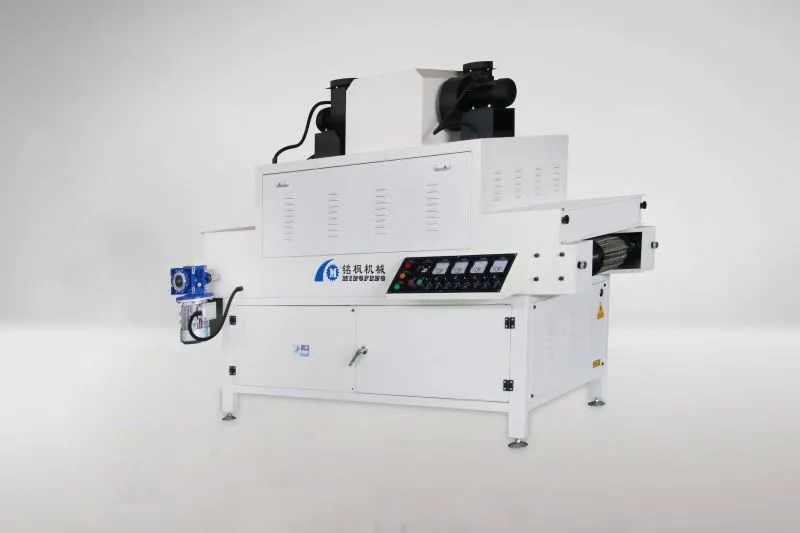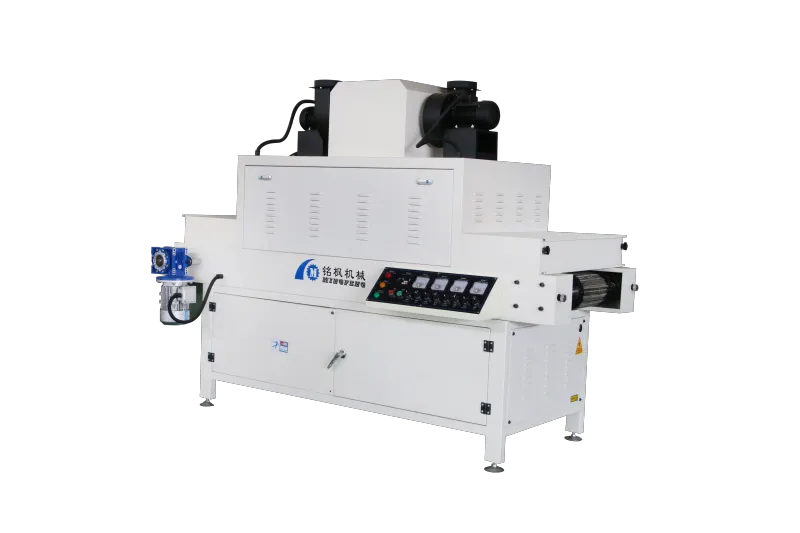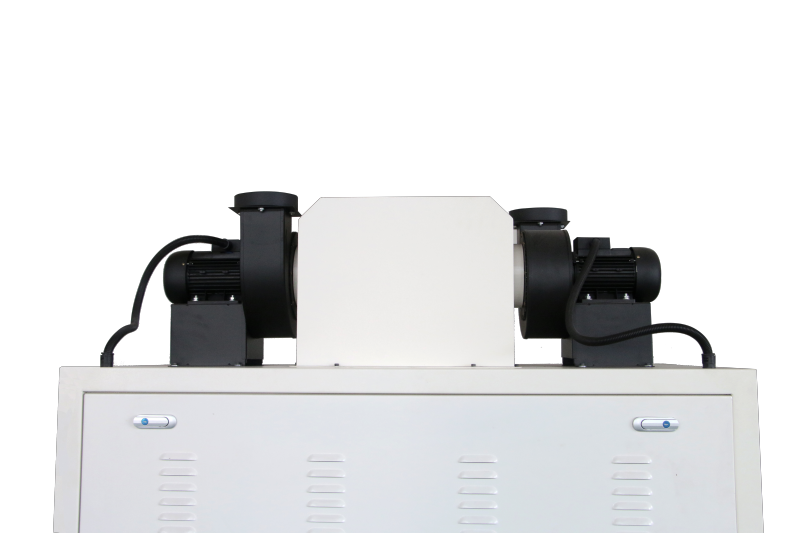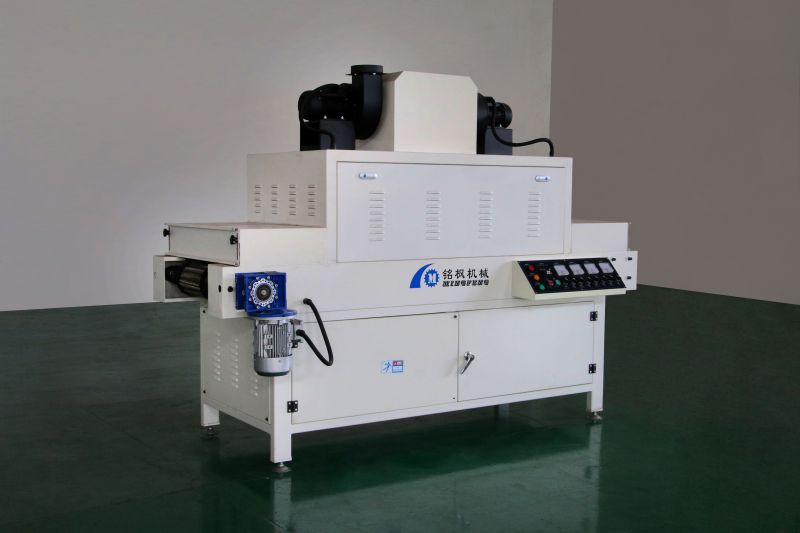Ultraviolet (UV) light and UV paint dryer machines can indeed damage unprotected wood under certain conditions. However, within a standardized industrial coating process, the risk of unacceptable damage to finished wood using a UV paint dryer can be significantly reduced or even avoided through proper light source selection, parameter control, coating system design, and process protection measures.
Below, I will explain each aspect of damage: why it occurs, its mechanisms, factors that determine risk, specific problems that may occur, and how to prevent and detect them. This will help you understand the issues clearly and implement the process correctly.

How does UV light "act" on wood?
UV light affects wood primarily through two pathways:
1. Photochemical Action
UV light is absorbed by chemical components in wood (especially lignin, pigments, and terpenoid extracts), causing molecular breakage and oxidation, and the formation of new chromophores. This leads to color change (fading or darkening/yellowing), fiber surface degradation, and surface brittleness.
2. Thermal and Mechanical Stress
High-intensity UV light sources are often accompanied by infrared/thermal energy output and close-range heating, which can cause surface temperature rise, leading to moisture evaporation, stress concentration, and changes in the adhesion between the paint film and the substrate. This can lead to cracking, blistering, shrinkage stress, or surface roughening. Furthermore, some mercury lamps produce ozone in the short-wavelength range, and chemically active gases can contribute to surface degradation or affect coating formation.
Thus, UV radiation is not simply a "light" effect, but rather the result of a combination of photochemical and thermodynamic effects. Whether or not it causes "damage" depends on multiple factors, including the spectrum (wavelength), dose (energy x time), thermal load, substrate characteristics, and the presence of a protective coating.
How do different wavelengths of UV light affect wood differently?
Which type of light is most critical for UV paint dryer machines?
UV radiation is broadly categorized by wavelength as UVC (100–280 nm), UVB (280–315 nm), and UVA (315–400 nm). Industrial UV curing typically uses the near-UV/UVA wavelength range (approximately 320–400 nm), particularly LED UV, which mostly emits in the 365–405 nm range. Traditional mercury vapor lamps have a broader emission spectrum, encompassing multiple peaks between 250 and 400 nm.
• UVC/shortwave (< 280 nm) has high energy, shallow penetration, and high chemical reactivity, rapidly destroying organic molecules—most significantly damaging wood. However, this shortwave wavelength is generally not used for curing (and produces ozone).
• UVB strongly degrades lignin, and long-term exposure can cause rapid discoloration and embrittlement of wood.
• UVA/near-UV is a commonly used wavelength range for industrial curing and is effective for coating photoinitiators, but it still has cumulative photochemical effects on the wood itself, especially at high doses or with repeated exposure, resulting in measurable photodegradation.
Therefore, the spectral choice (LED vs. mercury lamp) and wavelength used in UV paint dryer machines are crucial for wood safety. Narrow-spectrum LEDs (385–405 nm) generally have a relatively mild direct photochemical cracking effect on wood, but this requires the photoinitiator in the coating to be compatible with this wavelength. Mercury lamps, while offering strong curing capabilities and a wide wavelength range, have greater long-term impacts on wood if they contain a high proportion of short-wavelength components.

Will UV curing damage wood?
UV curing is not a purely "cold light" process. Traditional mercury lamp systems, in particular, emit significant amounts of visible and infrared light, raising the surface temperature of the workpiece. Thermal effects on wood include:
• Instantaneous temperature rise causes rapid evaporation of surface moisture, creating internal and surface moisture gradients that induce stress and microcracks;
• High temperatures accelerate chemical reactions, causing certain extractives (resins and oils) in the wood to migrate to the surface, resulting in blooming, sticky residue, or downstream adhesion issues;
• Temperature affects the film-forming behavior of the coating. Excessively high temperatures can accelerate surface curing, trapping solvents in the underlying layer, and forming bubbles or pinholes.
Therefore, cooling and airflow management in UV paint dryer machines, lamp-to-workpiece distance, line speed, and instantaneous power are all critical parameters for avoiding heat damage.
Which woods or boards are most susceptible to UV damage?
Different wood species and engineered boards have significantly different sensitivities to UV/heat:
• Light-colored hardwoods and bare wood rich in lignin: Lignin strongly absorbs UV, resulting in noticeable discoloration upon exposure.
• Wood species high in extractives (oils, monoterpenes, etc.) (such as some softwoods or aromatic woods): Heating or UV exposure can cause these components to migrate, resulting in discoloration or sticky residue.
• Engineered boards (MDF, plywood, particleboard): The surface may contain glue, wax, or adhesives, which can release gases when exposed to UV/heat, affecting coating film formation. Furthermore, thin veneers or melamine paper surfaces may delaminate or deform under high-energy exposure.
• Substrates with high or very low moisture content: Moisture levels alter heat conduction and stress distribution, increasing the risk of cracking.
Natural wood without a sealer or protective layer, as well as some engineered boards, are more susceptible to problems during UV curing, so process design must be based on the substrate's characteristics.

Why are UV paint dryer machines still widely used?
How does it balance efficiency and material safety?
Protection Mechanism—The key lies in the protective properties of the coating itself and the proper design of process parameters:
1. Once formed, the UV-curable coating effectively shields against UV rays and external chemical attack
A highly cross-linked clear topcoat acts as a barrier, reducing subsequent direct UV exposure to the wood. This means that a proper primer-thin-layer cure-topcoat strategy can effectively protect the wood with the coating.
2. Select a formulation that matches the substrate
For example, coatings containing UV absorbers and light stabilizers (such as HALS) can absorb harmful wavelengths within the film and slow substrate degradation.
3. Low-heat, narrow-spectrum LED light sources
Narrow near-UV wavelengths (e.g., 385–405 nm) and low infrared output ensure cure while reducing thermal load on the substrate and chemical damage caused by short-wavelength light.
4. Multi-stage energy and line speed control
By adjusting the lamp power and line speed in stages, each thin layer is fully cured while avoiding excessive instantaneous energy buildup.
In summary, UV paint dryer machines themselves are not inherently harmful; it's the process and materials that ultimately determine their safety.
How can you minimize damage to wood when using a UV paint dryer machine? (Key Operational Tips)
The following are systematic protective and control measures for easy implementation in the workshop:
1. Selecting a Suitable Light Source
Prioritize narrow-spectrum, low-infrared LED UV (if the paint is compatible) to reduce heat load and ozone generation. If using a mercury lamp, ensure light filtering and ozone treatment.
2. Coating System Design
• Use a primer/sealer compatible with UV curing to seal substrate pores and block migratory materials.
• Add UV absorbers and light stabilizers to the topcoat.
• Apply multiple, thin coats, fully curing each layer, to avoid applying thick layers and curing them all at once.
3. Strictly Control Line Speed, Lamp Power, and Distance
Adjust the energy dose according to the paint supplier's specifications to ensure sufficient curing without overexposing the substrate.
4. Cooling and Ventilation
The equipment must be equipped with an adequate air or water cooling system to cool the lamp body and the workpiece surface to prevent excessive surface temperatures. Effective ozone and volatile emissions must also be managed.
5. Substrate Pretreatment
Degrease, polish, and control moisture content within an appropriate range (usually a moderate moisture content) to prevent surface residue from affecting paint film adhesion.
6. Partial Shielding and Backside Protection
For areas that need to be shielded from direct exposure (backsides, openings, slots), use blackout paper or set process flow to avoid repeated exposure.
7. Sample and Process Verification
Before each material or coating change, perform complete curing, abrasion resistance, adhesion, and color difference testing on representative samples. Only after verification can mass production commence.
8. Equipment Maintenance and Online Testing
Regularly clean reflectors and replace aging lamps. Monitor output power using a radiometer to avoid blindly increasing power due to spectral shifts or intensity drops.
These measures can minimize the conflict between the advantages of UV treatment (fast speed, low VOC, and high hardness) and the fragility of wood.

How can you determine if UV treatment has "damaged" the wood?
Answer (Testing Method): The following criteria are often used in process evaluation:
• Appearance inspection: Color difference (ΔE), yellowness index, gloss unevenness, and surface defects (bubbles, pinholes, and roughness).
• Adhesion testing: Cross-cut test, tensile or peel test.
• Abrasion and solvent resistance testing: MEK rub test, multiple wet-dry abrasion cycles.
• Hardness testing: Pencil hardness, König or Barkhof hardness, etc.
• Humidity and heat cycling and dimensional stability: Humidity and heat cycling is used to evaluate the compatibility of the paint film with the substrate and observe for warping, peeling, or cracking.
• Accelerated aging/light aging tests (e.g., UV-chamber accelerated testing): used to evaluate color difference and degradation under long-term light exposure (Note: Accelerated test conditions must correspond to actual operating conditions).
These tests can be performed in small batches to establish acceptance thresholds and guide production parameters.
"Does UV damage wood?"
—Conclusive Answer:
If UV is applied directly, intensely, and for extended periods to bare wood or in an inappropriate process environment, it can indeed cause photochemical degradation (discoloration, fiber embrittlement), thermal damage (cracking, blistering), and adhesion issues related to the substrate.
However, in actual industrial coating applications, a UV paint dryer machine is typically combined with a sealer coat (primer/topcoat), a suitable light source (preferably a narrow-spectrum, low-heat LED or filtered mercury lamp), appropriate line speed and cooling design, and optimized formulation of UV absorbers/stabilizers in the coating. These measures effectively protect the wood and leverage the high speed, high hardness, and low VOC benefits of UV curing.
Therefore, the key lies in "process design and execution": As long as the UV paint dryer machine is correctly selected, the coating is matched and parameters are strictly controlled, and the substrate and process are thoroughly validated, UV will not cause unacceptable damage to the finished wood.
Why is Foshan XMF Machinery Co., Ltd. a reliable coating equipment supplier?
With over 15 years of experience and a strategic location in Foshan, Guangdong, XMF Machinery combines expert R&D, strict quality control, and excellent customer service. Our factory produces durable, affordable coating machines suitable for diverse industries and markets. Buyers seeking a trustworthy, cost-effective supplier benefit from our global reach, technical expertise, and customized solutions.
